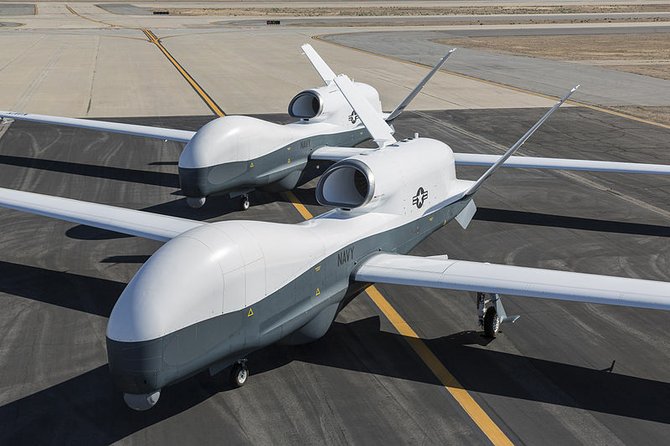 Facebook
Facebook
 X
X
 Instagram
Instagram
 TikTok
TikTok
 Youtube
Youtube

The initial phase of testing for the billion-dollar Triton unmanned aerial vehicle has concluded, defense contractor Northrop Grumman announced today.
While General Atomics and its Predator and Reaper drones receive much of the local spotlight shone on military drones, Northrop Grumman's Broad Area Maritime Surveillance crew, based out of San Diego, began testing the MQ-4C Triton in Palmdale last May.
After 13 actual flights and "thousands of hours of simulated flight tests," two Triton units are headed for Naval Air Station Patuxent River, Maryland, for further research. During the first round of testing, remote pilots flew the drones at heights of nearly 60,000 feet and in endurance tests lasting as long as 81 hours.
Once cleared for use, the machines will "allow military commanders to gather high-resolution imagery, use radar to detect targets, and provide airborne communications and information-sharing capabilities to military units across long distances," according to the company
In addition to the two prototypes, the Navy intends to purchase another 68 of the drones, with the cost estimated at $137 million each — actually closer to $189 million each including research and development, according to a a March 2013 Government Accountability Office report.
By comparison, General Atomics Reaper units cost taxpayers about $31 million each, though over 400 of the machines have been delivered or are on order.


The initial phase of testing for the billion-dollar Triton unmanned aerial vehicle has concluded, defense contractor Northrop Grumman announced today.
While General Atomics and its Predator and Reaper drones receive much of the local spotlight shone on military drones, Northrop Grumman's Broad Area Maritime Surveillance crew, based out of San Diego, began testing the MQ-4C Triton in Palmdale last May.
After 13 actual flights and "thousands of hours of simulated flight tests," two Triton units are headed for Naval Air Station Patuxent River, Maryland, for further research. During the first round of testing, remote pilots flew the drones at heights of nearly 60,000 feet and in endurance tests lasting as long as 81 hours.
Once cleared for use, the machines will "allow military commanders to gather high-resolution imagery, use radar to detect targets, and provide airborne communications and information-sharing capabilities to military units across long distances," according to the company
In addition to the two prototypes, the Navy intends to purchase another 68 of the drones, with the cost estimated at $137 million each — actually closer to $189 million each including research and development, according to a a March 2013 Government Accountability Office report.
By comparison, General Atomics Reaper units cost taxpayers about $31 million each, though over 400 of the machines have been delivered or are on order.
Comments